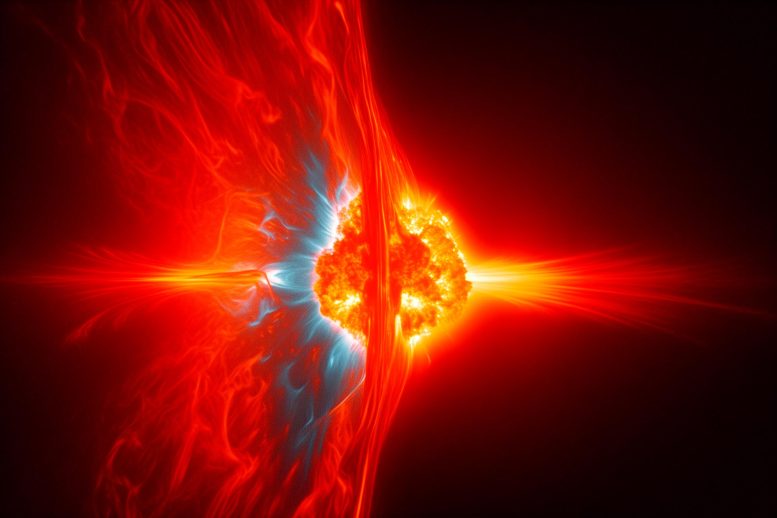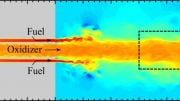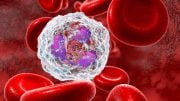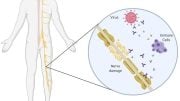
Caltech Professor Paul Bellan’s two-decade research on plasma jets reveals unexpected behaviors in ‘cold’ plasmas. Initially theorizing a collision-avoidance mechanism for electron acceleration, Bellan later disproved this through simulations, discovering that some electrons, by rarely losing energy in near-ion passes, continuously accelerate and produce X-rays. This finding, significant for understanding solar flares and fusion experiments, challenges conventional plasma theories. Credit: SciTechDaily.com
Caltech’s plasma jet experiments led by Paul Bellan reveal novel electron behaviors, contributing to understanding solar flares and fusion energy.
For around 20 years, Caltech Professor of Applied Physics Paul Bellan and his group have been creating magnetically accelerated jets of plasma, an electrically conducting gas composed of ions and electrons, in a vacuum chamber big enough to hold a person. (Neon signs and lightning are everyday examples of plasma).
In that vacuum chamber, wisps of gas are ionized by several thousand volts. One hundred thousand amps then flow through the plasma, producing strong magnetic fields that mold the plasma into a jet traveling around 10 miles per second. High-speed recordings show that the jet transitions through several distinct stages in a few tens of microseconds.
Bellan says the plasma jet looks like an umbrella growing in length. Once the length reaches one or two feet, the jet undergoes an instability that causes it to transform into a rapidly expanding corkscrew. This rapid expansion triggers a different, faster instability that creates ripples.
“The ripples choke the jet’s 100-kiloamp electric current, much like putting your thumb over a water hose restricts the flow and creates a pressure gradient that accelerates water,” Bellan says. “Choking the jet current creates an electric field strong enough to accelerate electrons to high energy.”
Surprising Discoveries in Plasma Behavior
Those high-energy electrons were previously identified in the jet experiment by the X-rays they generate, and Bellan says their presence was a surprise. That’s because conventional understanding says the jet plasma was too cold for electrons to be accelerated to high energy. Note that “cold” is a relative term: Although this plasma had a temperature of about 20,000 Kelvin (35,500 degrees Fahrenheit)—far hotter than anything humans normally encounter—it is nowhere near the temperature of the Sun’s corona, which is over a million Kelvin (1.8 million degrees F.)
“So, the question is, ‘Why are we seeing X-rays?'” he says.
Cold plasmas were thought to be incapable of generating high-energy electrons because they are too “collisional,” meaning an electron cannot travel very far before colliding with another particle. It is like a driver trying to drag race through freeway gridlock. The driver might hit the accelerator but would travel only a few feet before smashing into another car. In the case of a cold plasma, an electron would accelerate only about one micron before colliding and slowing down.
The Bellan group’s first attempt at explaining this phenomenon was a model suggesting that some fraction of the electrons manages to avoid colliding with other particles during the first micron of travel. According to the theory, that allowed the electrons to accelerate to slightly higher velocity, and once going faster, they could travel just a little bit farther before encountering another particle with which they might collide. Some fraction of those now-faster electrons would again avoid a collision for a time, allowing them to attain an even higher speed, which would allow them to travel even farther, creating a positive feedback loop that would allow a few lucky electrons to go farther and faster, attaining high speeds and high energies.
But while compelling, the theory was wrong, Bellan says.
“It was realized that this argument has a flaw,” he says, “because electrons don’t really collide in the sense of hitting something or not hitting something. They are all actually deflecting a little bit all the time. So, there’s no such thing as an electron that’s colliding or not colliding.”
New Insights From Computer Simulations
Yet, high-energy electrons do appear in the cold plasma of the jet experiment. To find out why, Bellan developed a computer code that calculated the actions of 5,000 electrons and 5,000 ions continuously deflecting off each other in an electric field. To suss out how a few electrons were managing to reach high energies, he tweaked the parameters and watched how the electrons’ behavior changed.
As electrons accelerate in the electric field, they pass near ions but never actually touch them. Occasionally, an electron whizzes so closely past an ion that it transfers energy to an electron attached to the ion and slows down, with the now “excited” ion radiating visible light. Because electrons only occasionally pass so closely, they usually just deflect slightly from the ion without exciting it. This occasional energy leakage occurs in most electrons, which means they never attain high energies.
When Bellan tweaked his simulation, a few high-energy electrons capable of creating X-rays appeared. “The lucky few that never come close enough to an ion to excite it never lose energy,” he adds. “These electrons are continuously accelerated in the electric field and ultimately attain sufficient energy to produce the X-rays.”
Bellan says that if this behavior occurs in the plasma jet in his Caltech lab, it probably happens in solar flares and astrophysical situations as well. This may also explain why unexpectedly high-energy X-rays are sometimes seen during fusion-energy experiments.
“There’s a long history of people seeing things that they thought were useful fusion,” he says. “It turns out it was fusion, but it wasn’t really useful. It was intense transient electric fields produced by instabilities accelerating a few particles to extremely high energy. This might be explaining what was going on. That’s not what people want, but it is probably what happens.”
The paper describing the work appeared in the October 20 issue of Physics of Plasmas and was presented on November 3 at the 65th Annual Meeting of the American Physical Society Division of Plasma Physics in Denver, Colorado.
Reference: “Energetic electron tail production from binary encounters of discrete electrons and ions in a sub-Dreicer electric field” by Paul M. Bellan, 20 October 2023, Physics of Plasmas.
DOI: 10.1063/5.0167004
Funding for the research was provided by the National Science Foundation and the Air Force Office of Scientific Research.









From accretion disks to quantum spins, topological vortices can provide infinite rotational force for many galaxies, celestial bodies, and microparticles. The synchronous effect of the superposition and deflection of topological vortices makes motion more complex. The physical essence of nuclear fusion is the synchronous effect of topological vortices.
Your Redefining Physics has not fundamentally solved the problem. Both academic journals and scientific workers must respect the seriousness of science. Scientists should not believe in pseudoscience like the Physical Review Letters (PRL) do. They firmly believe that two objects (such as two sets of cobalt-60) rotating in opposite directions can form a mirror image of each other.
The so-called quantum, its physical essence is the spin of topological vortices. Spin generates gravity. Spin generates energy. Spin generates evolution. Spin generation time.
The correct understanding and application of the rotation of topological vortices is an urgent issue in human science.
Love the image shows a great characterisation of the action, I do so ever look at it as a expanding balloon field that accepts the plasma in one form and exhausts thru the field as a X-ray.
We never make the human behaviour.. immune .. and other thing about circle